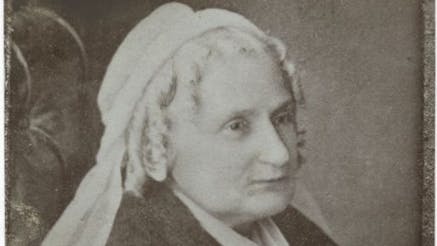Washington's War Tent After the Civil War: A Family Affair
February 2016, Adapted July 2021By Paul Davis
This is the second in a two-part series about the fate Washington's Headquarters Tent between the end of the Civil War and the start of the 20th century. Miss Part 1? Read it here.
---
April 9, 1901
“The remaining question is whether, as Chief Executive, you have the power to deliver these articles to the rightful owner. I think you have....”

Based on this recommendation to President William McKinley by John K. Richards, the Acting Attorney General, George Washington's tents were about to be returned to the Lee Family — nearly forty years after his descendant Mary Anna Randolph Custis Lee was forced to abandoned them along with her beloved Arlington House at the start of the Civil War. Mary Lee’s protracted struggle to reclaim her family’s heirlooms was not won during her lifetime.
After her death in 1873, The Lee family’s fight to regain possession of their property fell to the next generation. George Washington Parke Custis Lee, as his mother’s eldest son, was (according to the terms of his grandfather’s will) the successor and owner of Arlington House — now a cemetery for Union soldiers — and Washington’s tents. In 1877 he sued the Federal Government for the return of the Arlington House property. The case dragged on for five years but was ultimately decided in his favor by the United States Supreme Court. Faced with the awful prospect of disinterring the 17,000 soldiers now buried in Arlington National Cemetery, the U.S. government instead purchased the land from the Lee family for $150,000.
With the issue of Arlington now resolved, George Washington Parke Custis Lee turned his attention to getting back the Washington relics. Like the fight to reclaim Arlington House, the fight to reclaim the heirlooms confiscated from the family home took years. Successive presidential administrations either ignored or put off repeated petitions for their return. In 1887, Attorney General A. H. Garland advised President Grover Cleveland that the matter needed to be decided by Congress and that the President of the United States did not have the authority to comply with Lee’s request.
By 1901, petitions were delivered to the McKinley administration, but this time with very different results. In a five-page memorandum to the President, Acting Attorney General Richards wrote that George Washington Parke Custis Lee had clear title to Washington’s tents under the terms of his grandfather’s will. Further, he wrote, “The Government never took any steps to divest the title thus transmitted, and it does not appear that in any valid way it attempted to assert any title of its own.”
Richards recommended to the President that Washington’s tents be returned to the Lee family, under President McKinley’s authority:
“Your predecessor took possession of them during a time of war when the person in whose care the owner had left them was unable to protect them, and when they were consequently exposed to the risk of destruction. Being of great historical value and common interest to all the people, the President naturally and patriotically intervened for their preservation. But now that the need for such protection has ceased, and the owner requests their return, I believe the President has power to restore them to the person entitled under the law to their possession. Their restoration now is quite as much within the scope of Executive authority as has been their preservation.”
Accordingly, on May 1, 1901, President McKinley — the last President in United States History to have also been a Civil War veteran — authorized the return of Washington’s tents and other relics to George Washington Parke Custis Lee.
To the nation, President McKinley’s decision was symbolic of just how far the country had come in healing the wounds of the Civil War. For the Lee family, it meant that their long fight to get their property back was over.

Part One: At the end of the Civil War, a new battle begins for Mary Anna Randolph Custis Lee.
Read More